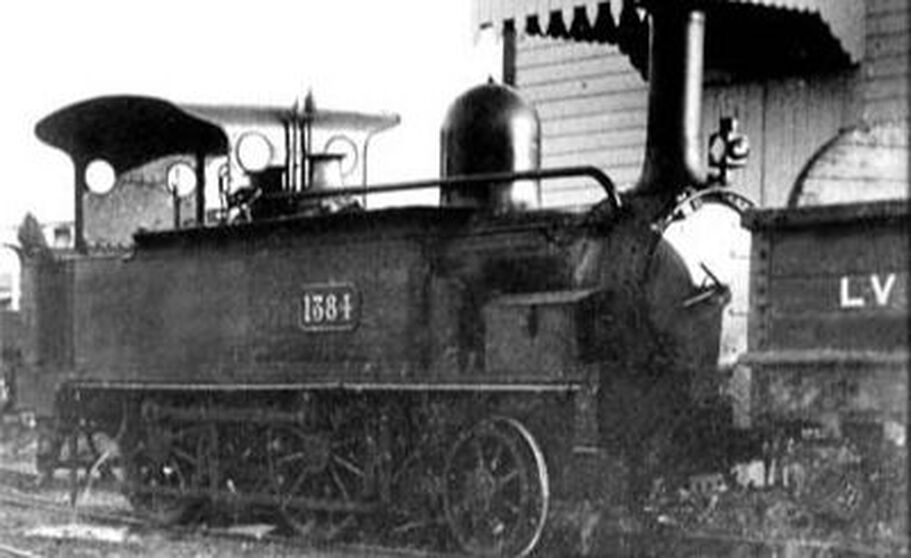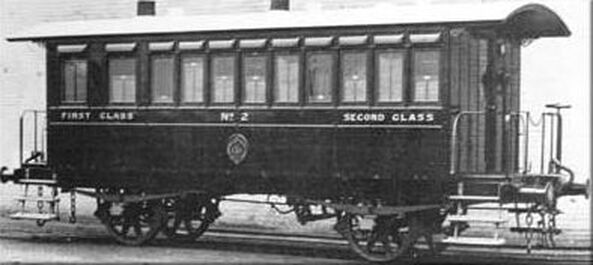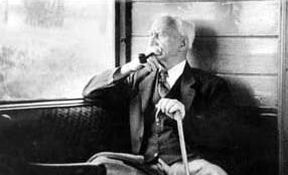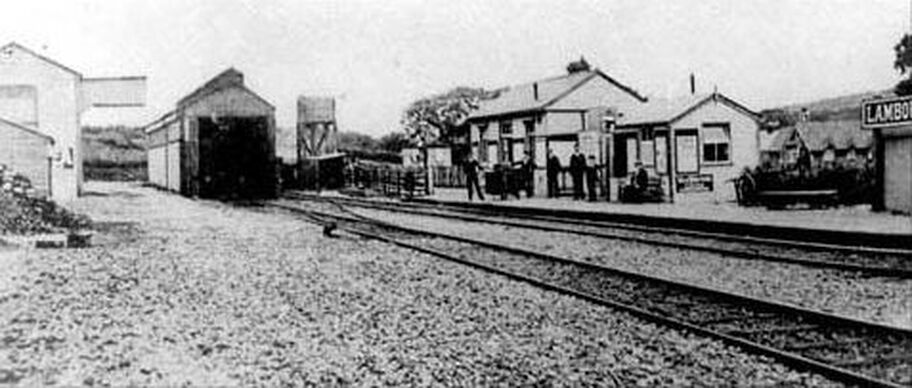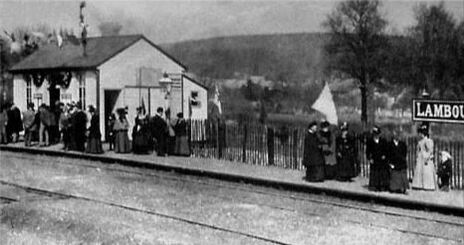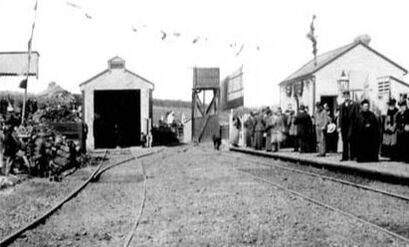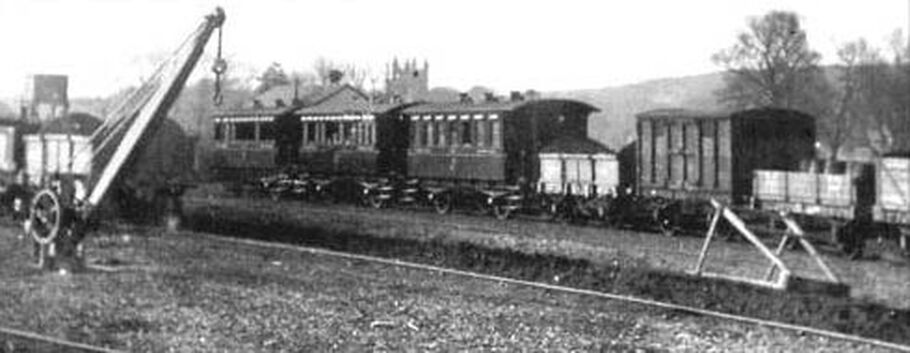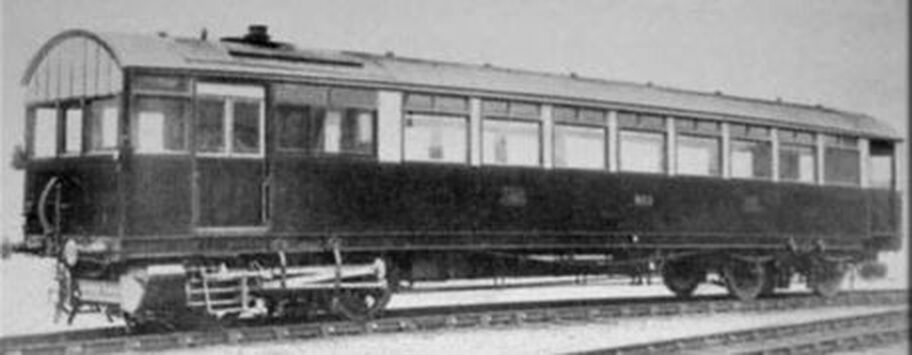How it all started
The idea of running a railway from Newbury to Lambourn, not least as a way of boosting Lambourn's declining agricultural trade, emerged much earlier than the physical reality of the Lambourn Valley Railway.
The Newbury and Lambourn Tramway Company was formed in late 1873. A 3ft gauge single track would be laid at the side of the main road, with several short branches within Newbury. It was to be horse-drawn, the vehicle making two round trips daily at first. The cost was estimated at £30,000 and an authorising Act was obtained on 7th August 1875, with one year allowed for construction. A contract for construction was let and a first rail was ceremonially fixed. However, subscribers did not come forward and shares to the value of £4,000 only were taken up. The year expired and the company was wound up.
After one or two attempts to get authorisation for a light railway, an authorising Act was obtained on 2 August 1883. The Lambourn Valley Railway Company was incorporated, capital £100,000. It was to be a single line, heavy not light railway, built using the standard gauge. The estimated cost of infrastructure was £80,530.
The Company then needed to raise capital to start construction, although by January 1885 only £23,365 had been subscribed. It got worse.
The Newbury and Lambourn Tramway Company was formed in late 1873. A 3ft gauge single track would be laid at the side of the main road, with several short branches within Newbury. It was to be horse-drawn, the vehicle making two round trips daily at first. The cost was estimated at £30,000 and an authorising Act was obtained on 7th August 1875, with one year allowed for construction. A contract for construction was let and a first rail was ceremonially fixed. However, subscribers did not come forward and shares to the value of £4,000 only were taken up. The year expired and the company was wound up.
After one or two attempts to get authorisation for a light railway, an authorising Act was obtained on 2 August 1883. The Lambourn Valley Railway Company was incorporated, capital £100,000. It was to be a single line, heavy not light railway, built using the standard gauge. The estimated cost of infrastructure was £80,530.
The Company then needed to raise capital to start construction, although by January 1885 only £23,365 had been subscribed. It got worse.
Engineering the line
|
After a number of engineers had been hired and left, more time allowed through new Acts and land acquired, all drained away the Company's precious capital. Among the difficulties they faced was crossing the Kennet and Avon canal, the River Kennet and an area of soft ground, lifting the original cost estimate for building the line from £30,000 to over £100,000.
Eventually, the contractor S Pearson & Son of Westminster offered to complete the work for £33,000. A contract was agreed on 30 January 1897. Experienced engineers, Pearson's completed the line three weeks early, in 1898. They solved the problem of the marshy ground by constructing a bridge with piles that went down 14 yards. The track itself consisted of spiked, flat-bottomed rail for the whole 12 miles and 32 chains, which became one of the longest single-track lines in the south of England. Operated on the principle of single engine in steam, the LVR saved money not only because this mode of operation does not require signalling, but also because it decided that communication between stations via telephone was unnecessary. The LVR concluded an agreement with the GWR to join the line at Newbury. This involved the GWR building both a bay platform - Platform 3 - with a run-around loop on the northern side of the station, and the line out towards Lambourn as far as 1,000 yards west of Newbury Station, where the branch line would diverge fom the main line. The GWR charged £6,000 for this work, plus an annual charge of £25 for use of the bay platform and £50 for use of the tracks across the marshy West Fields. |
How the press saw it
The progress which is being made with the construction of the Lambourn railway is very gratifying and Newbury people evince their interest in the proceedings by making the project a favourite promenade on Sunday afternoons. The view to be gained from the embankment across the moors is a very pleasant one. The Kennet winding its circuitous way through the green meadows, the trees of Speen on one side, with the red-topped tower peeping through the woods of Hampstead on the other, and the hills of Hampshire bounding the distant horizon. The sun was shinghing brightly on Sunday, and the river was alive with boating parties and the line with promenaders. The moors, which once were deserted, save by the moorhen, the dab-chick and the water rat, presented a lively aspect, and plainly indicated the advance of civilization. Newbury Weekly News |
Engines and rolling stock
The winter of 1897-98 found the LVR facing not only the problem of achieving the completion of general construction work on time, but also the hurdle of acquiring locomotives and rolling stock.
In response, the company successfully negotiated the hire of a loco from the GWR. It was this arrangement with the Great Western that saw the arrival of No.1384 (below).
In response, the company successfully negotiated the hire of a loco from the GWR. It was this arrangement with the Great Western that saw the arrival of No.1384 (below).
The GWR, however, was not in favour of supplying rolling stock and its decision not to do so left the LVR with a major problem. The Chairman of the company, Colonel Archer-Houblon, came to the rescue by purchasing four four-wheeled carriages himself and hiring them to the LVR. They were acquired at a cost of £1,300 and each coach carried a plate proclaiming Col. Archer-Houblon as the owner. After an agreed number of payments had been realised, they would ultimately become the property of the LVR.
Each carriage had both 1st and 2nd class compartments and a total seating capacity of 32 persons. Second-class seating was of wooden construction and demanded a fare rate of roughly 1d a mile. The coaches had a central gangway with platforms at both ends. These platforms were fitted with wrought-iron safety railings and allowed the guard to walk the length of the train while it was in motion. The coaches were 26 feet 6 inches in length and were fitted with a vacuum brake. Just by way of comparison, today's railway coaches tend to be some three times longer at around 23 or even 26 metres.
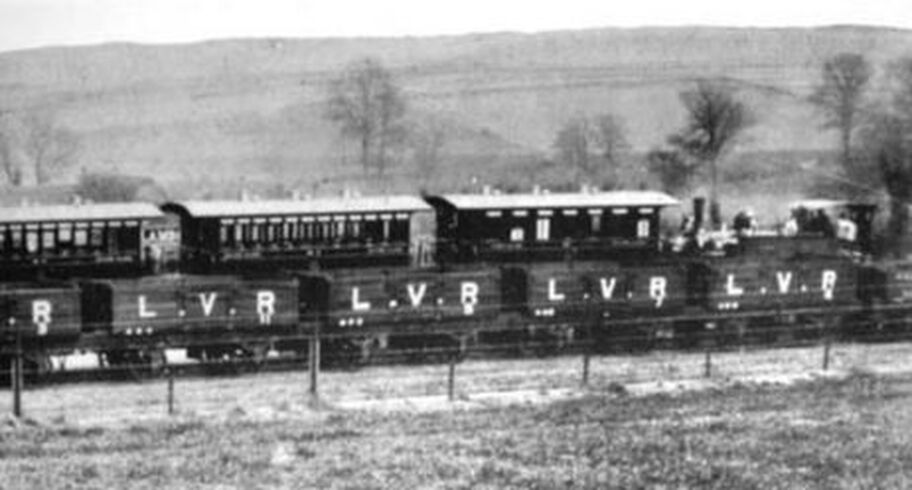
Goods rolling stock amounted to six second-hand GWR wagons acquired at a cost of £91/10/- (£91.50). A further 12 second-hand wagons were obtained from the Metropolitan Railway Carriage and Wagon Co. for £189. These were all funded by Col. Archer-Houblon and subject to the same type of agreement as the four carriages.
Company management
The senior officers for the LVR at this time were Mr. W.H.H.M. Gipps, General Manager; Mr. J.S. MacIntyre, Engineer; and Mr. H. Holmes, Company Secretary. All three individuals were instrumental in aiding the completion of the railway and would play an important part in its future operations. In addition to the General Managership of the LVR, Mr. Gipps was also the traffic manager for the nearby Didcot, Newbury and Southampton Railway.
The LVR opens for business
On 31st March 1898, the Board of Trade inspection of The Lambourn Valley railway took place. Inspecting Officer Col. Yorke declared that, subject to a speed limit of 25 miles an hour and axle loadings not exceeding 8 tons, the opening of the railway was approved. The private opening was set for Saturday 2nd April 1898, with the full public opening the following Monday, 4th April.
And so it was that at 10.30am, the inaugural train consisting of engine 1384 - borrowed from the GWR - and four LVR carriages stood in the new bay platform at Newbury station. The loco itself was bedecked in evergreens, festooned with flags, and a picture of the Queen was mounted on the front just above the buffers.
And so it was that at 10.30am, the inaugural train consisting of engine 1384 - borrowed from the GWR - and four LVR carriages stood in the new bay platform at Newbury station. The loco itself was bedecked in evergreens, festooned with flags, and a picture of the Queen was mounted on the front just above the buffers.
The invited dignitaries were duly welcomed by Colonel Archer-Houblon before being ushered to their places on board. A few minutes after 11am, the guard called "Take your seats please" and at 11.10am the first official passenger-carrying train departed for Lambourn terminus.
South Berkshire M.P. Mr. G Mount was aboard, his duty being to open the line officially on arrival at the terminus. Both he and Mr Gipps made the journey on the footplate along with the driver and fireman. Just 37 minutes after leaving Newbury, the train arrived in Lambourn welcomed by a celebratory peal of bells from the parish church and music from a local brass band. Two further trips were made that day, each carrying around 80 fare-paying passengers.
Two days later, on Monday 4th April, full public services started with five daily trains, plus an additional trip on Saturday evenings. Over 900 passengers were carried during the first week of scheduled operations.
South Berkshire M.P. Mr. G Mount was aboard, his duty being to open the line officially on arrival at the terminus. Both he and Mr Gipps made the journey on the footplate along with the driver and fireman. Just 37 minutes after leaving Newbury, the train arrived in Lambourn welcomed by a celebratory peal of bells from the parish church and music from a local brass band. Two further trips were made that day, each carrying around 80 fare-paying passengers.
Two days later, on Monday 4th April, full public services started with five daily trains, plus an additional trip on Saturday evenings. Over 900 passengers were carried during the first week of scheduled operations.
Although the line was now operational there were still several items that required completion, including a loading stage at Great Shefford, the platform at Stockcross and a small carriage shed, coal stage and siding at Lambourn itself. Early June saw the finalisation of this work, construction was brought to an end and the contractors duly paid off.
Passenger and goods traffic
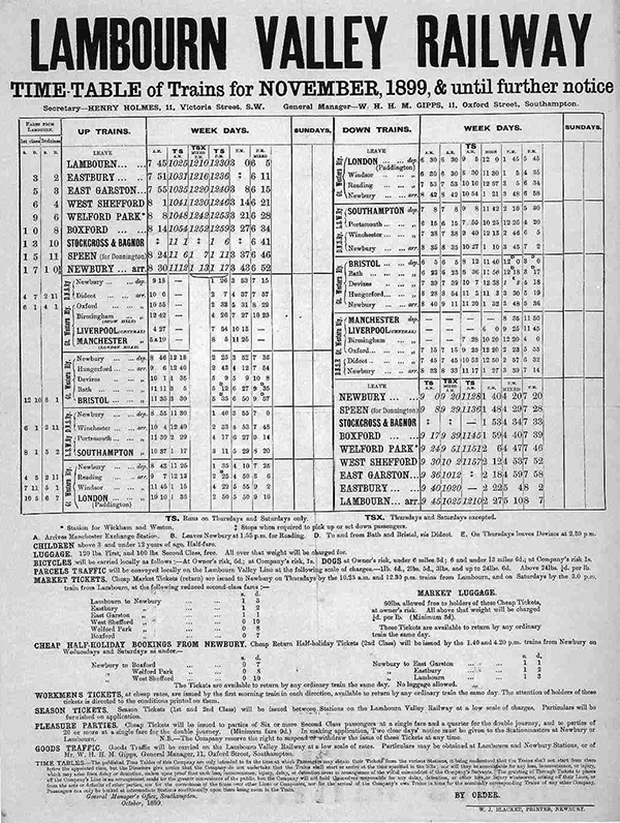
A timetable for 1899 has survived, and shows that the LVR operated a stopping passenger service from Lambourn of four trains a day for six days a week, departing at 7:45am, 12:10pm (mixed), 3:00pm and 6:05pm (mixed). On Thursdays and Saturdays, additional trains were inserted into the timetable, at 10:25am and 12:30pm to provide services for local market days, these services replacing the 12:10pm mixed train, which did not run.
From Newbury, the balancing services departed at 9:20am (mixed), 1:40pm, 4:20pm (mixed) and 7:20pm. The Thursday and Saturday market day specials ran at 9:00am and 11:28am, replacing the 9:20am mixed train.
The timetable showed connecting services to local destinations such as Oxford and Didcot, in addition to far-flung places like Liverpool, Manchester and London. It was also a wealth of ancillary information regarding fares for children, luggage and bicycle charges, market tickets, workmens' tickets and more.
So children between the ages of 3 and 12 paid half-fare, and any luggage over 100lb (45kg) in weight (120lb or 54kg in first class) was a chargeable item – presumably to cater for the additional time the porter would need to fetch a trolley. Travelling with a bicycle cost a princely shilling (5p). Meanwhile, second-class passengers from Lambourn paid less on market days too, via the LVR's issuance of Cheap Market Tickets (return only) on the 10:25am and 12:30pm trains on Thursdays, and the 2:00pm train on Saturdays.
With regard to freight and livestock traffic, the horse-racing industry was first to reap the benefits of the new line: within days of opening, horses were being carried in quantity using boxes hired from the Great Western Railway. Below you can see from the waybill that the LVR carried other forms of livestock and agricultural goods too.
From Newbury, the balancing services departed at 9:20am (mixed), 1:40pm, 4:20pm (mixed) and 7:20pm. The Thursday and Saturday market day specials ran at 9:00am and 11:28am, replacing the 9:20am mixed train.
The timetable showed connecting services to local destinations such as Oxford and Didcot, in addition to far-flung places like Liverpool, Manchester and London. It was also a wealth of ancillary information regarding fares for children, luggage and bicycle charges, market tickets, workmens' tickets and more.
So children between the ages of 3 and 12 paid half-fare, and any luggage over 100lb (45kg) in weight (120lb or 54kg in first class) was a chargeable item – presumably to cater for the additional time the porter would need to fetch a trolley. Travelling with a bicycle cost a princely shilling (5p). Meanwhile, second-class passengers from Lambourn paid less on market days too, via the LVR's issuance of Cheap Market Tickets (return only) on the 10:25am and 12:30pm trains on Thursdays, and the 2:00pm train on Saturdays.
With regard to freight and livestock traffic, the horse-racing industry was first to reap the benefits of the new line: within days of opening, horses were being carried in quantity using boxes hired from the Great Western Railway. Below you can see from the waybill that the LVR carried other forms of livestock and agricultural goods too.
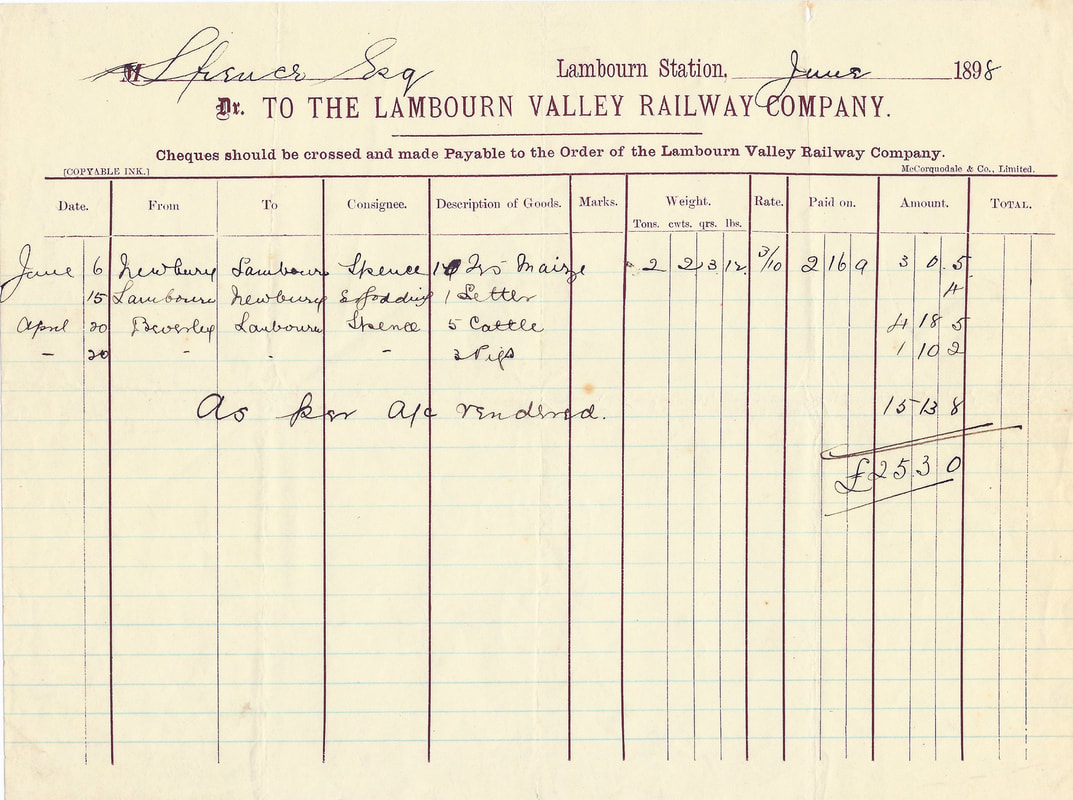
A goods waybill from June 1898 has survived, and is a reminder of the importance of goods traffic to the LVR. The goods carried were maize (weight 2 tons 2cwt 3qtrs 12lb) which was charged at £3/-/5 - or three pounds, no shillings, and fivepence - a letter charged at 4d (fourpence); five cattle (£4/18/5); and two pigs (£1/10/2), for a totoal of £25/3/-. Image courtesy Ian Dinmore - railarchive.org.uk
Financial woes
Five years on, change was in the air. The financial results of the first year of operation showed an operating profit of £954, making 19.7% of turnover. This was quite healthy, except that £857 8s 9d was due to Archer-Houblon as part of the agreed hire-purchase arrangement for rolling stock. So the company was losing money, with income failing to cover the cost of its debts.
In 1902, J B Squire was appointed as Managing Director of the Company. Commissioned to investigate economies, he recommended reducing the train service by one train daily, enabling a single engine to operate the service. All the goods work would be done in mixed trains, and there were later complaints about the delay to passengers in shunting.
On 14th July 1903, General Manager Mr. Gipps died after a brief illness and was replaced by Sidney Woodley. Mr. Woodley's appointment was set to start on 5th September 1903. Around this time, the GWR enquired about the possibility of taking over the line. The offer price was £45,000 and was reported at the time to have been greeted with some surprise by the Board of Directors. As the Board was still optimistic about the future of the LVR, the offer was politely declined.
Towards the end of 1903, the service was still being operated by one engine in steam. While services continued to run (see an 1899 timetable here), the financial situation was not good and was not improving. Once again, in January 1904, the GWR approached the board with a slightly increased take-over offer of £50,000 for the line and all its fixtures and fittings. Again, on the advice of its Managing Director, J.B Squire, the LVR rejected the deal.
The business relationship between the two railway companies remained very amicable, with the GWR suggesting that the smaller company run its services using steam-powered railmotors as opposed to the current set-up. The GWR offered to rent two railmotors to the LVR for the total sum of £420 per year. The idea seemed an attractive one and the LVR decided in favour of the proposed plan.
In 1902, J B Squire was appointed as Managing Director of the Company. Commissioned to investigate economies, he recommended reducing the train service by one train daily, enabling a single engine to operate the service. All the goods work would be done in mixed trains, and there were later complaints about the delay to passengers in shunting.
On 14th July 1903, General Manager Mr. Gipps died after a brief illness and was replaced by Sidney Woodley. Mr. Woodley's appointment was set to start on 5th September 1903. Around this time, the GWR enquired about the possibility of taking over the line. The offer price was £45,000 and was reported at the time to have been greeted with some surprise by the Board of Directors. As the Board was still optimistic about the future of the LVR, the offer was politely declined.
Towards the end of 1903, the service was still being operated by one engine in steam. While services continued to run (see an 1899 timetable here), the financial situation was not good and was not improving. Once again, in January 1904, the GWR approached the board with a slightly increased take-over offer of £50,000 for the line and all its fixtures and fittings. Again, on the advice of its Managing Director, J.B Squire, the LVR rejected the deal.
The business relationship between the two railway companies remained very amicable, with the GWR suggesting that the smaller company run its services using steam-powered railmotors as opposed to the current set-up. The GWR offered to rent two railmotors to the LVR for the total sum of £420 per year. The idea seemed an attractive one and the LVR decided in favour of the proposed plan.
Steam railmotors arrive - and disappear
On 3rd May 1904, the Board of Trade again inspected the line, necessary because railmotors' axle loading came out at 12 tons and the line had previously been sanctioned only for 8 tons. Nevertheless, the railmotors were deemed acceptable, and they started working the line on 15th May. Locomotives continued to haul the goods services for a further four weeks. Additional economies were made by removing the lad porters from the intermediate stations and allocating ticket collection duties to the guard.
So on 15th June, the now-redundant LVR locomotives and rolling stock were withdrawn from service and removed to Swindon to await auction. This event took place in November 1904, and finally, Chairman Col. Archer-Houblon could recoup his original capital outlay.
The LVR also found itself a new Engineer, Mr. J.N Taylor, succeeding Mr. MacIntyre who had resigned some weeks earlier. Mr Taylor oversaw the operation of the new railmotors, all of which worked as planned over the first months. There was still talk of a GWR take-over though, and on 7th November an official announcement by the GWR confirmed that talks were indeed taking place. This time however, there would be no increase in the previous offer price of £50,000.
In early 1905, it was discovered that the unusually high chalk content in the water supply at Lambourn was having an adverse effect on the power output of the small-boilered railmotors. Their performance had deteriorated to such a degree that they were struggling to haul tail traffic. It was so bad that the LVR had to return to loco-hauled services for the last few months of independence. The loco and carriages were again hired from the GWR. Modified railmotors eventually returned to the line in May 1905 and worked alongside locomotive power units where necessary.
However, the LVR had come full circle and was in a situation that undoubtedly caused some degree of embarrassment and anxiety to its Board of Directors.
So on 15th June, the now-redundant LVR locomotives and rolling stock were withdrawn from service and removed to Swindon to await auction. This event took place in November 1904, and finally, Chairman Col. Archer-Houblon could recoup his original capital outlay.
The LVR also found itself a new Engineer, Mr. J.N Taylor, succeeding Mr. MacIntyre who had resigned some weeks earlier. Mr Taylor oversaw the operation of the new railmotors, all of which worked as planned over the first months. There was still talk of a GWR take-over though, and on 7th November an official announcement by the GWR confirmed that talks were indeed taking place. This time however, there would be no increase in the previous offer price of £50,000.
In early 1905, it was discovered that the unusually high chalk content in the water supply at Lambourn was having an adverse effect on the power output of the small-boilered railmotors. Their performance had deteriorated to such a degree that they were struggling to haul tail traffic. It was so bad that the LVR had to return to loco-hauled services for the last few months of independence. The loco and carriages were again hired from the GWR. Modified railmotors eventually returned to the line in May 1905 and worked alongside locomotive power units where necessary.
However, the LVR had come full circle and was in a situation that undoubtedly caused some degree of embarrassment and anxiety to its Board of Directors.
The GWR acquires the LVR
This was clearly all too much for the LVR board so, in January 1905, approval was given by both boards to the amalgamation of the two companies and a date set for the official take-over. As a consequence, the LVR line became a GWR line on the first of July 1905, with most of the staff continuing their employment under the GWR.
A final meeting was held by both boards at Paddington on 19th July 1905. From that day, the independent Lambourn Valley Railway Company was no more. The Great Western Railway Company now had the task of bringing the line up to its own high exacting standards, reported at the time to cost an estimated £75,000.
Read on to find out what happened next...
A final meeting was held by both boards at Paddington on 19th July 1905. From that day, the independent Lambourn Valley Railway Company was no more. The Great Western Railway Company now had the task of bringing the line up to its own high exacting standards, reported at the time to cost an estimated £75,000.
Read on to find out what happened next...
